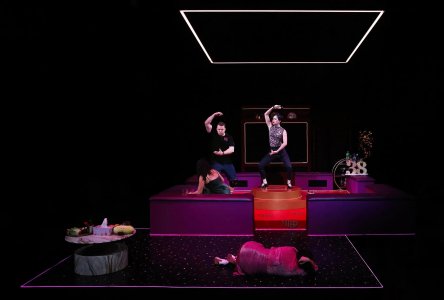
THIS MUCH IS TRUE
THIS MUCH IS TRUE, Redline Productions at the Old Fitz, 12 July-12 August 2017. Photography by John Marmaras: above - l-r Justin Stewart Cotta, Danny Adcock, Robin Goldsworthy, Septimus Caton and Joanna Downing; below - Alan Dukes, Robin Goldsworthy and Ashley Lyons; below again - the company with, far right, Martin Jacobs
Through his play writing life, Louis Nowra has been coming to grips with aliens and thereby coming to grips with his own alienation from the weirdness that is human life in suburbia (Summer of the Aliens); human life in crisis (Cosi) and now, human life in the microcosm of a city’s aged underbelly – This Much Is True.
The Rising Sun pub – aka Nowra’s real-life local, the Old Fitzroy – is the setting for the third part of a loose, semi-autobiographical trilogy whose link is Lewis/Louis (Septimus Caton). The boy of the first and the young man of the second is now forty-something and a writer. He walks into the pub’s grungy-comfy bar for the first time and a new chapter begins.
Lewis is the narrator of the piece, which puts him both outside the action and also draws in the audience via his shared confidences. It’s a classic device and Caton’s easy charm and confidence as Lewis sets the tone for the play’s two hours. They effortlessly zip by in the company of a mob of characters for whom the description “colourful” is inadequate.
These unlikely companions range from Alan Dukes’ down-at-heel authority and well-disguised anger as local debt collector, Malcolm; Joanna Downing’s deceptively perky prettiness as Gretel, the young barmaid, and Robin Goldsworthy’s equally deceptive sweet appeal as the new neighbour Rhys whose apparent bad luck has landed him in the rough end of town.

Justin Stewart Cotta shines as Venus, a sardonic, ex-star of the drag scene who’s not giving up her stilettos or sequins any time soon; Danny Adcock is Cass, the local fixer whose gift of the gab is unstoppable even as his mate Clarrie (Martin Jacobs), the infamous master chemist, jousts with him over matters of philosophy and drug recipes. And last but absolutely not least, Ashley Lyons as Wesley, a man whose bipolar disorder makes him alternately tragic and the drollest company, depending on the day.
What happens between this rag-tag bunch in their everyday – every evening – world of the old bar is the steadily beating heart of the play. It’s a rich mix of mundane and extraordinary; dubious and magnificent. Truth is as liquid as the (non-craft) beers pulled from the pumps; morals are loose and swing in the sea breeze that comes up from the bay on hot nights, if they’re lucky. Needs and wants, wishes and hopes, dreams and nightmares are interchangeable and as easily disposed of as they are lost.
Lewis is a bemused observer of the various plots and sub-plots. On the face of it he’s too much an outsider to be outwardly shocked or emotionally engaged by what he witnesses; on the other hand, what is gradually revealed in This Much Is True is how heart-felt and deeply engaged Lewis/Louis is with his characters. They leap off the page and into life and their humanity glows even as their flaws show up like the pesky flaws in glass that are the bane of Clarrie’s life. (Why do flaws in glass matter to a meth chemist? You’ll have to see the play to find out; it’s one of the many revelations that burst like bungers throughout the action.)
Director Toby Schmitz is currently doing his nightly thing at Belvoir in The Rover, so the crediting of Andrew Henry as assistant director is probably more significant than usual. In any event, both seem to understand and love these people as much as their creator does. The way the characters are placed in the drama, and how their passage on and off stage are orchestrated, enhances the narratives and brightens the dark and crazy moments to dazzling effect. It’s a satisfying production – no sense of much need for further work on the text or workshopping that plagues so many new plays.

Anna Gardiner’s set design of a beer-stinky, fag smoke-stained old pub is made delightfully smellier and grubbier through Matt Cox’s lighting and Martelle Hunt’s accurate to a white patent stiletto boot costumes. The atmosphere is also heightened by Jed Silver’s sound design of bits and pieces of jukebox detritus and it’s sweetly spooky to be part of it.
This Much Is True is true to its place yet also universal in its humour, pathos, people and humanity. Easy to imagine it being produced in London or any other city with a history of working-class bar life as substitute for home and family for those in need. Meanwhile, this is an achievement everyone involved can be proud of and audiences should be banging the door down for tickets. A bit of history is being made and a gorgeous entertainment is to be had by all. Recommended without reservation.



